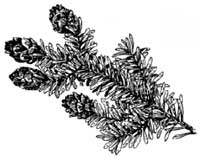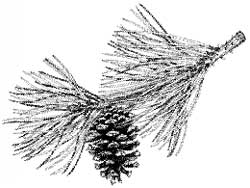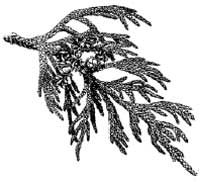| Natural Notes |
National Park Service U.S. Department of the Interior 2002-2003 North Cascades National Park Service Complex |

|
Life zones in the North Cascades
| Alpine Zone: Above 7000' only the most hardy survive the harsh elements and lack of water and soil. Sedges and grasses in the meadows are interspersed with alpine flowers. | ||
|
Westside Forests Subalpine Zone: At 5000' to 7000' in elevation on the north slopes and throughout the North Cascades you find meadows, shrubfields and patches of stunted trees. Fragile plants such as heather, partridge foot and Sitka valerian flourish in high elevation meadows. The shrubfields include slide alder and false azalea. Numerous alpine and subalpine flowers like phlox, Indian paintbrush, elephant head, columbine, Davidson's penstemon and mountain lupine cover the slopes. Mountain Hemlock Zone: The highest area of continuous forest on the west side, 4000' to 5000' or more in elevation depending on exposure, includes mountain hemlock, Alaska yellow cedar, pacific fir and subalpine fir. Shrubs found at these elevations include false azalea, mountain ash and slide alder. Understory plants include twisted stalk and queen's cup. Silver Fir Zone: At mid-elevation, 2000' to 4000', the trees found are primarily the pacific silver fir, western hemlock, western redcedar and sometimes Douglas fir. Shrubs found here are huckleberry and false azalea. The forest floor is similar to the Western Hemlock Zone, with a thick understory including Oregon grape, salal and many ferns. Western Hemlock Zone: Consists of lowland forests along the west side river valleys. Dominant trees are western hemlock, western redcedar and Douglas fir. Shrubs and ground cover include vine maple, red huckleberry bushes, thimbleberry, sword fern, trillium and foam flower. In undisturbed areas the ground, tree trunks and branches are covered with mosses, mushrooms and lichens. The cool moist maritime climate provides plenty of rainfall, maintaining this forest community. |

|
Eastside Forests Eastside Meadow & Subalpine Fir Zone: At 4000' to 6500' elevation you'll find subalpine fir, Engelmann spruce, subalpine larch and whitebark pine mixed with a variety of other trees. Shrubs at these elevations are cascade mountain ash, white rhododendron, Oregon boxwood and huckleberry. The understory is much more open in this drier community due to less precipitation than on western slopes. The mountains act as a barrier against wet air moving inland off the Pacific Ocean and Puget Sound casting a rainshadow across the eastern slopes. Douglas Fir & Lodgepole Pine Zone: This mid-elevation, 2000' to 4000', eastside community is primarily Douglas fir and lodgepole pine mixed with Ponderosa pine, grand fir and western larch. The understory consists of Douglas maple, oceanspray, bitterbrush, pine grass, mountain boxwood and spirea. |
 Western Hemlock
(Tsuga heterophylla) The "State Tree of Washington" commonly grows with other trees due to its ability to thrive in dense shade. Young trees often start on "nurse logs," hence the phenomenon of straight rows of trees. Flat, blunt needles have two fine white lines underneath. The small rounded cones help easily distinguish this tree from the mountain hemlock, which has much longer cones and often grows as a low sprawling shrub on high wind-swept slopes. |
 Ponderosa Pine
(Pinus ponderosa) Ponderosa pine needles grow in bunches of two or three and are the longest of any pine in Washington. A large tree, 170' tall and 3' in diameter, it grows best on well drained soils and is extremely drought resistant. |
 Western Redcedar
(Thuja plicata) Among the native peoples of the region, the redcedar had many uses including clothing, shelter, rope, nets, tools and more. Redcedar thrives in moist, shady areas and can grow up to 200' tall and more than 10' in diameter. The distinctive scale-like needles have a resinous odor when crushed. Small upright cones are scattered near the branch ends, while the trunk is fluted with stringy bark. |
 Douglas fir
(Pseudotsuga menziesii) This coastal variety of Douglas fir is common in the low to mid elevations of North Cascades and grows rapidly up to 300' tall and 6' in diameter. This tree thrives best in areas cleared by fire where sunlight is plentiful. Needles are single along a twisted stem, resembling a bottle brush. Brown distinct cones have characteristic three lobed bracts extending beyond the scales. |
| <<< Previous | > Cover Page < | Next >>> |